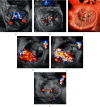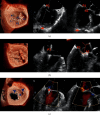Real-Time Monitoring and Step-by-Step Guidance for Transapical Mitral Valve Edge-to-Edge Repair Using Transesophageal Echocardiography
- PMID: 33976590
- PMCID: PMC8084671
- DOI: 10.1155/2021/6659261
Real-Time Monitoring and Step-by-Step Guidance for Transapical Mitral Valve Edge-to-Edge Repair Using Transesophageal Echocardiography
Abstract
MitraClip edge-to-edge (E2E) repair system is the only transcatheter device recommended in the current guidelines for treating mitral regurgitation (MR). The percutaneous femoral venous transseptal access of MitraClip requires a complex steerable delivery system and may thus be technically complex to optimally position and deploy the clip onto the mitral valve. A transapical approach for E2E repair has been devised to treat MR for the ease of operation (ValveClamp system, Hanyu Medical Technology, Shanghai). The first-in-human study of ValveClamp has demonstrated its early feasibility and effectiveness for the treatment of patients with degenerative MR. Transesophageal echocardiography (TEE) is the only imaging modality required for intraoperative guidance of ValveClamp implantation. Successful implantation depends on accurate localization and orientation of the clamp and efficient intraoperative communication between the echocardiographer and the intervention team. Thus, the focus of this review is on elaborating how two-dimensional (2D) and three-dimensional (3D) TEE are used in clinical practice to guide ValveClamp implantation and it may facilitate the understanding of simplicity and safety of this novel procedure. We also describe the implementation of several novel advancements in 3D TEE imaging, which improve the confidence of image interpretation for intraoperative guidance and expedite implantation times.
Copyright © 2021 Zhenyi Ge et al.
Conflict of interest statement
Dr. Daxin Zhou and Dr. Wenzhi Pan are consultants for Hanyu Medical Technology. All the other authors have reported that they have no relationships relevant to the content of this paper to disclose.
Figures








Similar articles
-
Percutaneous Transcatheter Edge-to-Edge MitraClip Technique: A Practical "Step-by-Step" 3-Dimensional Transesophageal Echocardiography Guide.Mayo Clin Proc. 2019 Jan;94(1):89-102. doi: 10.1016/j.mayocp.2018.10.007. Mayo Clin Proc. 2019. PMID: 30611459 Review.
-
Transcatheter Mitral Valve Repair Using the Edge-to-Edge Clip.J Am Soc Echocardiogr. 2018 Apr;31(4):434-453. doi: 10.1016/j.echo.2018.01.012. Epub 2018 Mar 1. J Am Soc Echocardiogr. 2018. PMID: 29482977 Review.
-
Isolated mitral valve P3 prolapse with severe regurgitation - transoesophageal 2D/3D echo-guidance in transapical -artificial neochordae implantation in challenging patient.Acta Cardiol. 2017 Jun;72(3):347-348. doi: 10.1080/00015385.2017.1305179. Epub 2017 Mar 21. Acta Cardiol. 2017. PMID: 28636512 No abstract available.
-
Optimized guidance of percutaneous edge-to edge repair of the mitral valve using real-time 3-D transesophageal echocardiography.Clin Res Cardiol. 2011 Aug;100(8):675-81. doi: 10.1007/s00392-011-0296-1. Epub 2011 Mar 3. Clin Res Cardiol. 2011. PMID: 21369924
-
Quantitative Three-Dimensional Echocardiographic Correlates of Optimal Mitral Regurgitation Reduction during Transcatheter Mitral Valve Repair.J Am Soc Echocardiogr. 2019 Nov;32(11):1426-1435.e1. doi: 10.1016/j.echo.2019.06.014. Epub 2019 Aug 26. J Am Soc Echocardiogr. 2019. PMID: 31466850
Cited by
-
Clinical feasibility study of transcatheter edge-to-edge mitral valve repair in dogs with the canine V-Clamp device.Front Vet Sci. 2024 Dec 9;11:1448828. doi: 10.3389/fvets.2024.1448828. eCollection 2024. Front Vet Sci. 2024. PMID: 39717788 Free PMC article.
-
Step-by-step transesophageal echocardiographic guidance for transjugular transcatheter tricuspid valve replacement with a radial force-independent bioprosthesis.Quant Imaging Med Surg. 2024 Jan 3;14(1):1061-1069. doi: 10.21037/qims-23-218. Epub 2024 Jan 2. Quant Imaging Med Surg. 2024. PMID: 38223060 Free PMC article. Review.
References
-
- Geyer M., Sotiriou E., Tamm A. R., et al. Advanced protocol for three-dimensional transesophageal echocardiography guidance implementing real-time multiplanar reconstruction for transcatheter mitral valve repair by direct annuloplasty. Journal of the American Society of Echocardiography. 2019;32(10):1359–1365. doi: 10.1016/j.echo.2019.05.015. - DOI - PubMed
Publication types
MeSH terms
LinkOut - more resources
Full Text Sources
